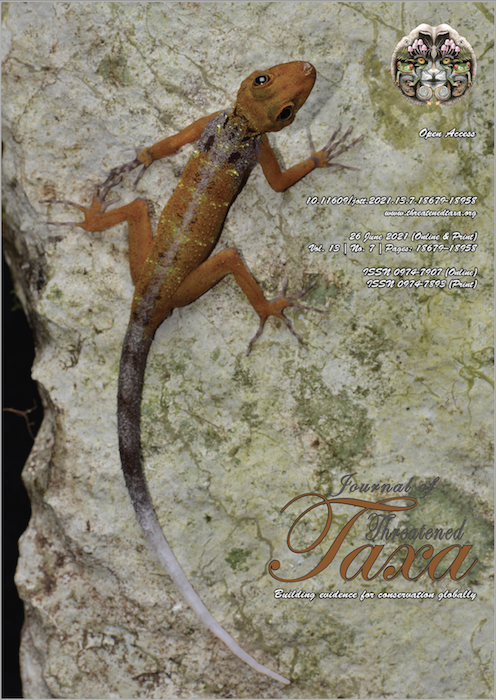Butterfly diversity of Putalibazar Municipality, Syangja District, Gandaki Province, Nepal
Main Article Content
Abstract
A study was carried out to find the butterfly species diversity and abundance in Putalibazar Municipality, Syangja, Gandaki, Nepal, from June 2019 to July 2020. Pollard walk method was used for data collection in three different habitat types: forest, agricultural land, and settlement area. The study was performed in all seasons: pre-monsoon, monsoon, post monsoon and winter. A total of 180 butterfly species from 108 genera and six families were recorded. The overall Shannon-Wiener diversity index (H) was 4.48. The highest diversity was represented by the Nymphalidae with 67 species (H= 3.79). Butterfly diversity and species abundance was highest in the forest area (147 species, 1199 individuals; H= 4.47). The highest species richness (109 species) was observed in the monsoon season.
Article Details

This work is licensed under a Creative Commons Attribution 4.0 International License.
Authors own the copyright to the articles published in JoTT. This is indicated explicitly in each publication. The authors grant permission to the publisher Wildlife Information Liaison Development (WILD) Society to publish the article in the Journal of Threatened Taxa. The authors recognize WILD as the original publisher, and to sell hard copies of the Journal and article to any buyer. JoTT is registered under the Creative Commons Attribution 4.0 International License (CC BY), which allows authors to retain copyright ownership. Under this license the authors allow anyone to download, cite, use the data, modify, reprint, copy and distribute provided the authors and source of publication are credited through appropriate citations (e.g., Son et al. (2016). Bats (Mammalia: Chiroptera) of the southeastern Truong Son Mountains, Quang Ngai Province, Vietnam. Journal of Threatened Taxa 8(7): 8953–8969. https://doi.org/10.11609/jott.2785.8.7.8953-8969). Users of the data do not require specific permission from the authors or the publisher.
References
Acharya, B.K. & L. Vijayan (2015). Butterfly diversity along the elevation gradient of eastern Himalaya, India. Ecological Research 30(5): 909–919. https://doi.org/10.1007/s11284-015-1292-0
Bhusal, D.R. & B. Khanal (2008). Seasonal and altitudinal diversity of butterflies in eastern Siwalik of Nepal. Journal of Natural History Museum 23: 82–87. https://doi.org/10.3126/jnhm.v23i0.1843
Blair, R.B. & A.E. Launer (1997). Butterfly diversity and human land use: Species assemblages along an urban grandient. Biological Conservation 80(1): 113–125. https://doi.org/10.1016/S0006-3207(96)00056-0
Khanal, B. (2006). The Late Season Butterflies of Koshi Tappu Wildlife Reserve, eastern Nepal. Our Nature 4(1): 42–47. https://doi.org/10.3126/on.v4i1.501
Khanal, B. (2008). Diversity and status of butterflies in lowland districts of west Nepal. Journal of Natural History Museum 23: 92–97. https://doi.org/10.3126/jnhm.v23i0.1846
Kehimkar, I. (2016). Butterflies of India. Bombay Natural History Society, Mumbai, 516pp.
Padhye, A.D., N. Dahanukar, M. Paingankar, M. Deshpande & D. Deshpandev (2006). Season and landscape wise distribution of butterflies in Tamhini, northern Western Ghats, India. Zoos’ Print Journal 21(3): 2175–2181. https://doi.org/10.11609/JoTT.ZPJ.1142.2175-81
Parmesan, C., N. Ryrholm, C. Stefanescu, J.K. Hill, C.D. Thomas, H. Descimon & W.J. Tennent (1999). Poleward shifts in geographical ranges of butterfly species associated with regional warming. Nature 399(6736): 579–583. https://doi.org/10.1038/21181
Pollard, E. (1977). A method for assessing changes in the abundance of butterflies. Biological Conservation 12(2): 115–134. https://doi.org/10.1016/0006-3207(77)90065-9
Sawchik, J., M. Dufrene & P. Lebrun (2005). Distribution patterns and indicator species of butterfly assemblages of wet meadows in southern Belgium. Belgian Journal of Zoology 135(1): 43–52.
Smith, C. (Eds.) (1994). Butterflies of Nepal (Central Himalaya). Tecpress Service LP, Bangkok, 367pp.
Smith, C. (2006). Illustrated Checklist of Nepal’s Butterflies. Craftsman Press, Bangkok, 129pp.
Smith, C. (2011). Butterflies of Nepal in Natural Environment. Himalayan Map House (P.) Ltd. Basantapur, Kathmandu, Nepal, 144pp.
Smith C., L. Sherpa & N. Shristi (2016). Butterflies of Begnas and Rupa Watershed Area, Pokhara, Nepal. LI-BIRD, 174pp.
Tiple, A.D. (2011). Butterflies of Vidarbha region, Maharashtra State, central India. Journal of Threatened Taxa 3(1): 1469–1477. https://doi.org/10.11609/JoTT.o2397.1469-77
Tiple, A.D., A.M. Khurad & R.L. Dennis (2007). Butterfly diversity in relation to a human-impact gradient on an Indian university campus. Nota Lepidopterologica 30(1): 179.
Tiple, A.D., V.P. Deshmukh & R.L. Dennis (2005). Factors influencing nectar plant resource visits by butterflies on a university campus: implications for conservation. Nota Lepidopterologica 28(3/4): 213–224.

